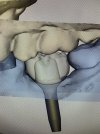Brett Hansen CDT
Well-Known Member
Full Member
- Messages
- 1,683
- Reaction score
- 102
I've been restoring a doctor's implant cases for over a decade. Never any issues seating the abutments. I've had three cases in the last month that she couldn't get seated. One of them was a screw retained Atlantis abutment case. She consulted with the periodontist and they think the abutment is hitting the bone. The perio also said he has started using shorter implants(all strauman bonelevel) recently. For this case, they think that bone on the mesial of the implant is holding up the abutment. Anyone have any ideas on what could be causing this issue? I've never run into in the molar region. I have seen this issue with doing screw retained bridges using straumann variobases in the anterior region of the mandible because the prosthesis is too thick under the tissue. It doesn't seem like the bone would be keeping the abutment from seating, but I am going to recontour the abutment on the mesial to relieve it more.



